Related Research Articles

The Australian Astronomical Observatory (AAO), formerly the Anglo-Australian Observatory, was an optical and near-infrared astronomy observatory with its headquarters in North Ryde in suburban Sydney, Australia. Originally funded jointly by the United Kingdom and Australian governments, it was managed wholly by Australia's Department of Industry, Innovation, Science, Research and Tertiary Education. The AAO operated the 3.9-metre Anglo-Australian Telescope (AAT) and 1.2-metre UK Schmidt Telescope (UKST) at Siding Spring Observatory, located near the town of Coonabarabran, Australia.
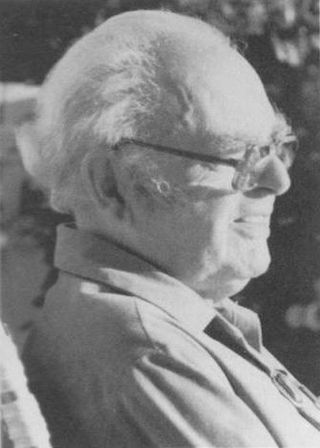
Bartholomeus Jan "Bart" Bok was a Dutch-American astronomer, teacher, and lecturer. He is best known for his work on the structure and evolution of the Milky Way galaxy, and for the discovery of Bok globules, which are small, densely dark clouds of interstellar gas and dust that can be seen silhouetted against brighter backgrounds. Bok suggested that these globules may be in the process of contracting, before forming into stars.
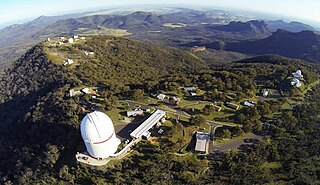
Siding Spring Observatory near Coonabarabran, New South Wales, Australia, part of the Research School of Astronomy & Astrophysics (RSAA) at the Australian National University (ANU), incorporates the Anglo-Australian Telescope along with a collection of other telescopes owned by the Australian National University, the University of New South Wales, and other institutions. The observatory is situated 1,165 metres (3,822 ft) above sea level in the Warrumbungle National Park on Mount Woorat, also known as Siding Spring Mountain. Siding Spring Observatory is owned by the Australian National University (ANU) and is part of the Mount Stromlo and Siding Spring Observatories research school.
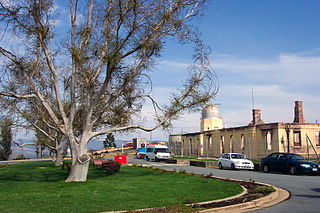
Mount Stromlo Observatory located just outside Canberra, Australia, is part of the Research School of Astronomy and Astrophysics at the Australian National University (ANU).
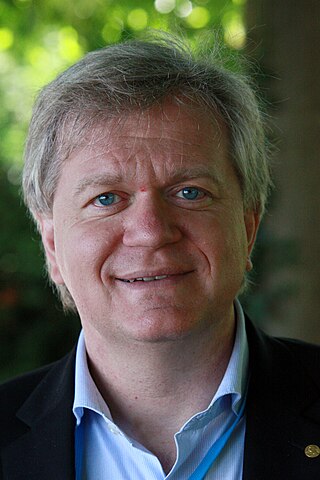
Brian Paul Schmidt is the Vice-Chancellor of the Australian National University (ANU). He was previously a Distinguished Professor, Australian Research Council Laureate Fellow and astrophysicist at the University's Mount Stromlo Observatory and Research School of Astronomy and Astrophysics. He is known for his research in using supernovae as cosmological probes. He currently holds an Australian Research Council Federation Fellowship and was elected a Fellow of the Royal Society (FRS) in 2012. Schmidt shared both the 2006 Shaw Prize in Astronomy and the 2011 Nobel Prize in Physics with Saul Perlmutter and Adam Riess for providing evidence that the expansion of the universe is accelerating, making him the only Montana-born Nobel laureate.
Lisa Jennifer Kewley is an Australian Astrophysicist and current Director of the Center for Astrophysics | Harvard & Smithsonian. Previously, Kewley was Director of the ARC Centre of Excellence for All Sky Astrophysics in 3-D and ARC Laureate Fellow at the Australian National University College of Physical and Mathematical Sciences, where she was also a Professor. Specialising in galaxy evolution, she won the Annie Jump Cannon Award in Astronomy in 2005 for her studies of oxygen in galaxies, and the Newton Lacy Pierce Prize in Astronomy in 2008. In 2014 she was elected a fellow of the Australian Academy of Science. In 2020 she received the James Craig Watson Medal. In 2021 she was elected as an international member of the National Academy of Sciences. In 2022 she became the first female director of the Center for Astrophysics | Harvard & Smithsonian.
Priscilla Fairfield Bok was an American astronomer and the wife of Dutch-born astronomer Bart Bok, Director of Mount Stromlo Observatory in Australia and later of Steward Observatory in Arizona, US. Their harmonious marriage accompanied the four decades of their close scientific collaboration, in which "it is difficult and pointless to separate his achievements from hers". They co-authored a number of academic papers on star clusters, stellar magnitudes, and the structure of the Milky Way galaxy. The Boks displayed great mutual enthusiasm for explaining astronomy to the public: described as "salesmen of the Milky Way" by The Boston Globe, their general interest book The Milky Way went through five editions and was said to be "one of the most successful astronomical texts ever written".

Kenneth Charles Freeman is an Australian astronomer and astrophysicist who is currently Duffield Professor of Astronomy in the Research School of Astronomy and Astrophysics at the Mount Stromlo Observatory of the Australian National University in Canberra. He was born in Perth, Western Australia in 1940, studied mathematics and physics at the University of Western Australia, and graduated with first class honours in applied mathematics in 1962. He then went to Cambridge University for postgraduate work in theoretical astrophysics with Leon Mestel and Donald Lynden-Bell, and completed his doctorate in 1965. Following a postdoctoral appointment at the University of Texas with Gérard de Vaucouleurs, and a research fellowship at Trinity College, Cambridge, he returned to Australia in 1967 as a Queen Elizabeth Fellow at Mount Stromlo. Apart from a year in the Kapteyn Institute in Groningen in 1976 and some occasional absences overseas, he has been at Mount Stromlo ever since.
Harvey Raymond Butcher III is an astronomer who has made significant contributions in observational astronomy and instrumentation which have advanced understanding of the formation of stars and of the universe. He received a B.Sc. in Astrophysics from the California Institute of Technology in 1969, where he contributed to the development of advanced infrared spectrometry applied in the first survey of the sky at infrared wavelengths.

Jennie Margaret McCormick, FRASNZ is a New Zealand amateur astronomer and asteroid discoverer who conducts astronomical research from the Farm Cove Observatory in Auckland. She discovered the asteroid officially named New Zealand and has contributed to and been involved in a range of organisations and events to promote astronomy. McCormick has published in several journals and won awards for her contributions to astronomy.
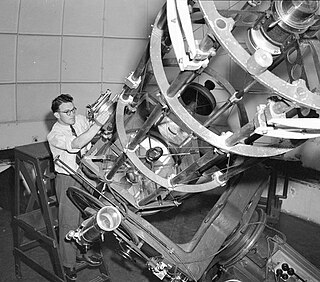
Sidney Charles Bartholemew "Ben" Gascoigne was a New Zealand-born optical astronomer and expert in photometry who played a leading role in the design and commissioning of Australia's largest optical telescope, the Anglo-Australian Telescope, which for a time was one of the world's most important astronomical facilities. Born in Napier, New Zealand, Gascoigne trained in Auckland and at the University of Bristol, before moving to Australia during World War II to work at the Commonwealth Solar Observatory at Mount Stromlo in Canberra. He became skillful in the design and manufacture of optical devices such as telescope elements.
Michael Andrew "Mike" Dopita was an Australian astronomer and Professor Emeritus at the Research School of Astronomy and Astrophysics, Australian National University, where he worked since 1975. He was the 1983 winner of the Pawsey Medal. He was elected Fellow of the Australian Academy of Science in 1996 and served as Treasurer of the Academy. He was president, Division VI, International Astronomical Union, from 1994 to 1997 and was a council member of the Astronomical Society of Australia between 1993 and 1996. He was a Fellow of that society. He was an Inaugural Federation Fellow of the Australian Research Council, 2001. He studied physics at Wadham College, Oxford.
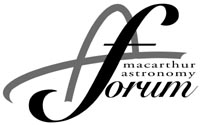
Macarthur Astronomy Forum is a monthly public forum organised by Macarthur Astronomical Society, providing leading national and international professional astronomers with a platform to address the Forum on topics of astronomical interest; also providing members of the Society and the general public with opportunities to learn and ask questions.
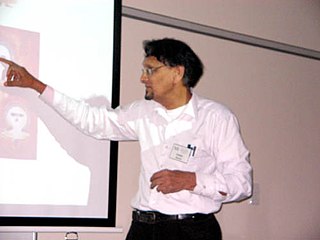
Ragbir BhathalFRSN, FRAS, FSAAS was an Australian astronomer and author, based at the Western Sydney University (WSU), Australia. He was known for his work on Optical Search for Extra-Terrestrial Intelligence (OSETI). He continued lecturing and research at WSU until he died at the age of 86 on 30 November 2022.
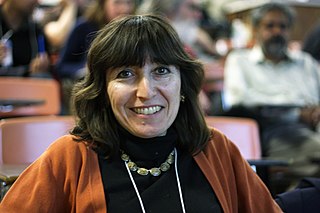
Wendy Laurel Freedman is a Canadian-American astronomer, best known for her measurement of the Hubble constant, and as director of the Carnegie Observatories in Pasadena, California, and Las Campanas, Chile. She is now the John & Marion Sullivan University Professor of Astronomy and Astrophysics at the University of Chicago. Her principal research interests are in observational cosmology, focusing on measuring both the current and past expansion rates of the universe, and on characterizing the nature of dark energy.

Warrick John Couch is an Australian professional astronomer. He is currently a professor at Swinburne University of Technology in Melbourne. He was previously the Director of Australia's largest optical observatory, the Australian Astronomical Observatory (AAO). He was also the president of the Australian Institute of Physics (2015–2017), and a non-executive director on the Board of the Giant Magellan Telescope Organization. He was a founding non-executive director of Astronomy Australia Limited.

Jessie Christiansen is an Australian astrophysicist working at the NASA Exoplanet Science Institute at the California Institute of Technology (Caltech). She won the 2018 NASA Exceptional Engineering Achievement Medal for her work on the Kepler planet sample.

Antoni Przybylski, , sometimes referred to as "Bill", was a Polish-Australian astronomer best known for discovering Przybylski's Star.
Karlie Alinta Noon is the first Indigenous woman in Australia to graduate with a double degree in maths and physics, an astronomer, of the Gamilaraay people, multiple award winner, 2019 Eureka Prize nominee, and one of the 2017 BBC's 100 Women. She is researching Astronomy and Astrophysics at the Australian National University, Australia.
Virginia Kilborn is a professor and radio astronomer with the Centre for Astrophysics and Supercomputing at Swinburne University and is Swinburne's first Chief Scientist. She researches galaxy evolution by studying their gas content and is working on the surveys of the next generation of radio telescopes, including the Australian SKA Pathfinder.
References
- 1 2 3 Sackett, Penny D. (22 August 2003). "Strategic Investment in Australian Research Infrastructure. A Submission to: The National Research Infrastructure Taskforce Department of Education, Science and Training" (PDF). Australian National University. Archived from the original (PDF) on 17 September 2006. Retrieved 30 September 2008. 19 pages.
- ↑ Millar, Lisa (30 September 2008). "Australia has new chief scientist". The World Today. Australian Broadcasting Corporation . Retrieved 30 September 2008.
The US born Australian citizen ..
- 1 2 "ANU congratulates Sackett on Chief Scientist role". Australian National University. 30 September 2008. Retrieved 30 September 2008.
- 1 2 3 4 5 Harrison, Dan (4 October 2008). "On a universal quest". The Age . Retrieved 3 October 2008.
- 1 2 3 4 Corner, Stuart (30 September 2008). "Penny Sackett is Australia's new chief scientist: full time". iTwire. Archived from the original on 1 October 2008. Retrieved 30 September 2008.
- ↑ "Forum – Science as a career". The Science Show. Australian Broadcasting Corporation. 7 October 2006. Retrieved 30 September 2008.
- 1 2 3 4 5 "Professor Penny D. Sackett". Research School of Astronomy and Astrophysics. Australian National University. Archived from the original on 7 May 2016. Retrieved 30 September 2008.
- ↑ "Mt Stromlo after the fire". The Science Show. Australian Broadcasting Corporation. Retrieved 30 September 2008.
- ↑ Woodford, James (17 January 2004). "Rebuilding stumbles on insurance hurdle but hope burns bright". The Sydney Morning Herald. Retrieved 30 September 2008.
- ↑ "Government appoints Penny Sackett as chief scientist". The Australian. 30 September 2008. Retrieved 30 September 2008.[ permanent dead link ]
- ↑ "ANU astronomer named new chief scientist". Australian Broadcasting Corporation. 30 September 2008. Retrieved 30 September 2008.
- ↑ "Chief Scientist Steps Down". Australian Broadcasting Corporation .
- 1 2 "Professor Penny Sackett Australia's New Chief Scientist". Media Release. Minister for Innovation, Industry, Science and Research. 30 September 2008. Archived from the original on 10 October 2008. Retrieved 30 September 2008.
- ↑ J.-P. Beaulieu; D.P. Bennett; P. Fouque; A. Williams; et al. (2006). "Discovery of a Cool Planet of 5.5 Earth Masses Through Gravitational Microlensing". Nature. 439 (7075): 437–440. arXiv: astro-ph/0601563 . Bibcode:2006Natur.439..437B. doi:10.1038/nature04441. PMID 16437108. S2CID 4414076.
{{cite journal}}: CS1 maint: multiple names: authors list (link) - ↑ "At Last! A Cool, Rocky Planet". RSAA News. Australian National University. January 2006. Retrieved 30 September 2008.